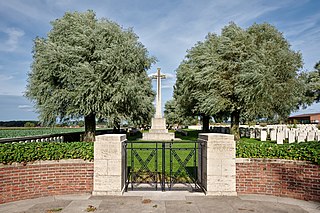
Lance Sergeant William Stephen Kenealy VC, was an Irish recipient of the Victoria Cross, the highest and most prestigious award for gallantry in the face of the enemy that can be awarded to British and Commonwealth forces.

Robert Morrow VC was a British recipient of the Victoria Cross, the highest and most prestigious award for gallantry in the face of the enemy that can be awarded to British and Commonwealth forces.
Eric Skeffington Poole was a British Army soldier who was the first commissioned officer to be executed by British military authority during World War I.
Victor Manson Spencer was a volunteer from Invercargill, New Zealand who fought in the Otago Infantry Regiment of the New Zealand Division in World War I. Spencer was executed for desertion on 24 February 1918, despite later suggestions that he was severely traumatised by shellshock, having fought and survived several campaigns.

Ypres Reservoir Cemetery is a Commonwealth War Graves Commission (CWGC) burial ground for the dead of the First World War located in the Ypres Salient on the Western Front.

Hyde Park CornerCemetery is a Commonwealth War Graves Commission (CWGC) burial ground in Belgium for the dead of the First World War, located in the village of Ploegsteert in the Ypres Salient on the Western Front.

Duhallow ADSCemetery is a Commonwealth War Graves Commission burial ground for the dead of the First World War located near Ypres on the Western Front in Belgium.

Private Peaceful is a novel for older children by British author Michael Morpurgo first published in 2003. It is about a fictional young soldier called Thomas "Tommo" Peaceful, who is looking back on his brother Charlie's execution by firing squad. The story focusses on the harsh realities of English rural life and warfare, and highlights the British Army's practice of executing its own soldiers during the First World War. Morpurgo was inspired to write the novel after learning about the around 300 British and Commonwealth soldiers who were shot for crimes like desertion and cowardice. The novel helped further the campaign to grant posthumous pardons to the men, which were agreed and implemented by the UK Government in 2006.

Chester Farm is a Commonwealth War Graves Commission burial ground for the dead of the First World War located in the Ypres Salient on the Western Front.

Spoilbank is a Commonwealth War Graves Commission burial ground for the dead of the First World War located in the Ypres Salient on the Western Front.

Prowse Point Military Cemetery is a Commonwealth War Graves Commission (CWGC) burial ground for the dead of the First World War located in the Ypres Salient on the Western Front in Belgium.

Bedford House Cemetery is a Commonwealth War Graves Commission burial ground for the dead of the First World War located near Zillebeke, itself near Ypres, on the Western Front in Belgium.

Menin Road South Military Cemetery is a Commonwealth War Graves Commission burial ground for the dead of the First World War located near Ypres, on the Western Front.
Lance Sergeant Joseph William Stones was a British soldier during the First World War who was executed for cowardice. He later became the first Briton so executed to have his name added to a war memorial.

Suffolk Cemetery is a Commonwealth War Graves Commission (CWGC) burial ground for the dead of the First World War located in Kemmel in the Ypres Salient on the Western Front.

Potijze Château Wood Cemetery is a Commonwealth War Graves Commission (CWGC) burial ground for the dead of the First World War located in the Ypres Salient on the Western Front.

Canadian Cemetery No. 2 is a Commonwealth War Graves Commission burial ground for the dead of World War I situated on the grounds of the Canadian National Vimy Memorial Park near the French town of Neuville-Saint-Vaast.

PerthCemetery is a Commonwealth War Graves Commission burial ground for the dead of the First World War located near Ypres (Ieper) in Belgium on the Western Front.

Grangegorman Military Cemetery is a British military cemetery in Dublin, Ireland, located on Blackhorse Avenue, parallel to the Navan Road and beside the Phoenix Park.

Herbert Francis Burden was a soldier in the British Expeditionary Force during the First World War. Born in 1898 in Lewisham, south-east London, Burden is generally accepted as having lied about his age in order to enlist at the age of 16. Having joined the 1st South Northumberland Fusiliers, he soon deserted, returned to London and joined the East Surrey Regiment, whom he also soon deserted. Rejoining his old battalion, he was sent to France when the army believed him to be 19 years old, and he probably fought at the Battle of Bellewaarde Ridge in May 1915. Having already gone absent without leave (AWOL) from his unit on multiple occasions, he left his post once again the following month—he said to see a friend in the neighbouring regiment—but he was arrested and accused of desertion. Found guilty, he was executed by firing squad two days later aged 17. In 2001 his case, and his image, was the basis for a memorial statue in the National Memorial Arboretum to those who had been unfairly executed by 20th-century standards. Five years later, Burden and the other men were granted pardons by the British government.


















